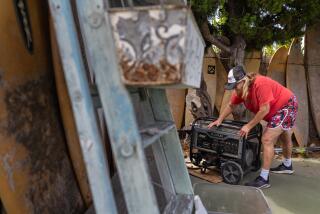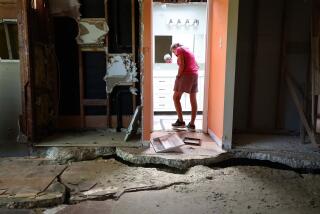On Shaky Ground : Commerce: Ventura Boulevard has been the economic lifeline of the Valley. The quake dealt it another in a series of jolts.
- Share via
The trembling of the ground has finally abated, but for shop owners up and down this once-busy stretch of Ventura Boulevard, business remains shaky.
Rather than the steady clang of cash registers, they hear the grinding of wrecking cranes outside their windows, knocking down office and apartment buildings rocked by the Northridge earthquake--the ones that once created the clientele they fear may never be replaced.
“More than half of my business comes from a one-mile radius,” said Michael Ourieff, owner of Michael J’s restaurant. “And now they’re gone, they’re all gone.”
The earthquake has been but the latest disaster to send shock waves along the once glitzy San Fernando Valley boulevard, which for years has seen its business base rocked by recession, where the “Grand Opening” signs of old have slowly been replaced by placards of a different sort: “Going Out of Business.”
*
Since the post-World War II consumer boom, the 17-mile-long commercial stretch has run across the Valley floor like an unabated river of retail, representing a healthy, buying, vibrant America. It was the Melrose Avenue of the San Fernando Valley, a sign that people north of the hill had their own economic, cultural and aesthetic centerpiece.
But recent years have been hard on the boulevard, where vacancy rates have soared and discount stores have popped up in choice locations as rents plummeted to as low as $1.25 per square foot, roughly half what was being charged before the recession.
Even as planners developed a vision for refurbishing the retail strip into the next century--a plan to create more parking and pedestrian access to compete with nearby malls and other retail drags throughout the Valley--business owners squabbled over how the plan’s $222-million price tag would be paid.
Today, as their prized boulevard reels from earthquake damage, politicians, business owners and residents are more fearful than ever over the future of the traffic-choked thoroughfare known as the Valley’s Main Street.
And for good reason. Between Studio City and Woodland Hills, 384 properties along Ventura Boulevard suffered more than $41 million in earthquake damage, according to a city building and safety report.
In Sherman Oaks, more than 165 buildings along the boulevard were damaged by the temblor--19 of them deemed unsafe and another 30 confined to limited entry, the report said.
“Ventura Boulevard got a huge punch in the stomach--it was knocked out, the smelling salts are being taken out all over the place,” said Michael Lushing, vice president of CB Commercial, a commercial real estate firm. “But it’s the heart of retail in the Valley--it can’t afford to be out.”
In an effort to reassure shaken businesses, U.S. Commerce Secretary Ronald H. Brown took a half-hour tour of quake-beleaguered Ventura Boulevard recently, looking at buckled buildings and talking to owners about how they planned to bring customers back.
Meeting with 40 business owners, Brown promised that the Clinton Administration would do what it could to cut bureaucratic red tape and see that redevelopment money in the form of grants and loans was rushed to the area.
Still, many owners feel economically adrift, waiting for help they fear may never come. “Brown said all the right things,” Ourieff said. “Now we just have to wait to see if they come true. But the clock is ticking away. A lot of people can’t wait for the life preserver. They’re going down too fast.”
Indeed, at a time when a future vision is most badly needed, the floor has literally been pulled out from thousands of white-collar workers who have been uprooted by the quake.
“More than a million and a half square feet of commercial office tenants have been displaced--5% of the entire Valley market--and another 500,000 square feet of small business space was damaged,” said Bruce Frasco, senior vice president of Beitler Commercial Realty, whose business was forced to moved from its 10,000-square-foot Sherman Oaks headquarters into a space one-third the size in Encino.
“These tenants are out on the street. And the problem is, for many, that their leases are still in effect,” Frasco said. “In most cases, the landlord has up to a year to rebuild the premises and 90 days just to inform you what he is going to do--tear down the building, or whatever.
“Meanwhile, many landlords aren’t willing to lease to businesses on a temporary basis until they can move back into their old haunts. So, people are literally out in the cold. They’re stuck in limbo. Time has become a killer.”
And many small businesspeople are faced with a conundrum: If they walk away from their shops, give them back to the banks, their employees will be back on the streets, out of work--adding to the quake’s economic blow to the community.
At the meeting with Brown, a Bullock’s vice president told him that his retail chain would lose $120 million in sales to the earthquake. More startling, he said, 300 employees had been laid off from the store’s Sherman Oaks location and another 300 in Northridge.
Indeed, even before last month’s temblor, the boulevard was at an economic crossroads, experts say--one that has been made more critical by the recent disaster.
Along one popular stretch between Beverly Glenn and Van Nuys boulevards, six of 18 shops sat empty at year’s start. Now that blight has been joined by earthquake-related eyesores: Broken light poles and cracks in the street and plywood covering former window displays.
There are “Now Leasing” and “Available” signs everywhere on most every block, as well as ones that cry “Earthquake menus!” and “Earth-shattering sales!”
“Look around,” said Brain, chairman of the Ventura Boulevard Specific Plan Review Board. “We’ve lost all the building blocks of a balanced community. Malls are damaged. Drugstores abandoned. The only hotel in Sherman Oaks has been declared unsafe. Grocery stores and multi-business office buildings--all declared unsafe. A local church is holding Masses in a tent out back.
“All of us are wondering what this boulevard and this community are going to look like a year from now. Are there going to be deserted lots every other blocks? We’re praying that doesn’t come to pass.”
*
Although no one would dare venture that Ventura Boulevard might benefit from the quake, many planners see Brown’s promises of financial support as the first ray of sunlight.
The quake has prompted some merchants to take a closer look at the Ventura Boulevard Specific Plan, a broad planning blueprint that aims to upgrade the infrastructure of the boulevard and control what residents had complained was runaway growth. The estimated cost of the project had been $222 million. Much of those funds were to come through “trip fees” assessed to businesses, based on how much traffic they generated.
Even before the quake, business owners complained that the fees were too high and suggested that other funding sources, perhaps an assessment district, be explored. Brain and other merchants have asked the city Planning Commission to cut the price tag of the plan to $100 million. The panel agreed to consider the proposal.
Times staff writer Aaron Curtiss contributed to this story.
More to Read
Inside the business of entertainment
The Wide Shot brings you news, analysis and insights on everything from streaming wars to production — and what it all means for the future.
You may occasionally receive promotional content from the Los Angeles Times.











